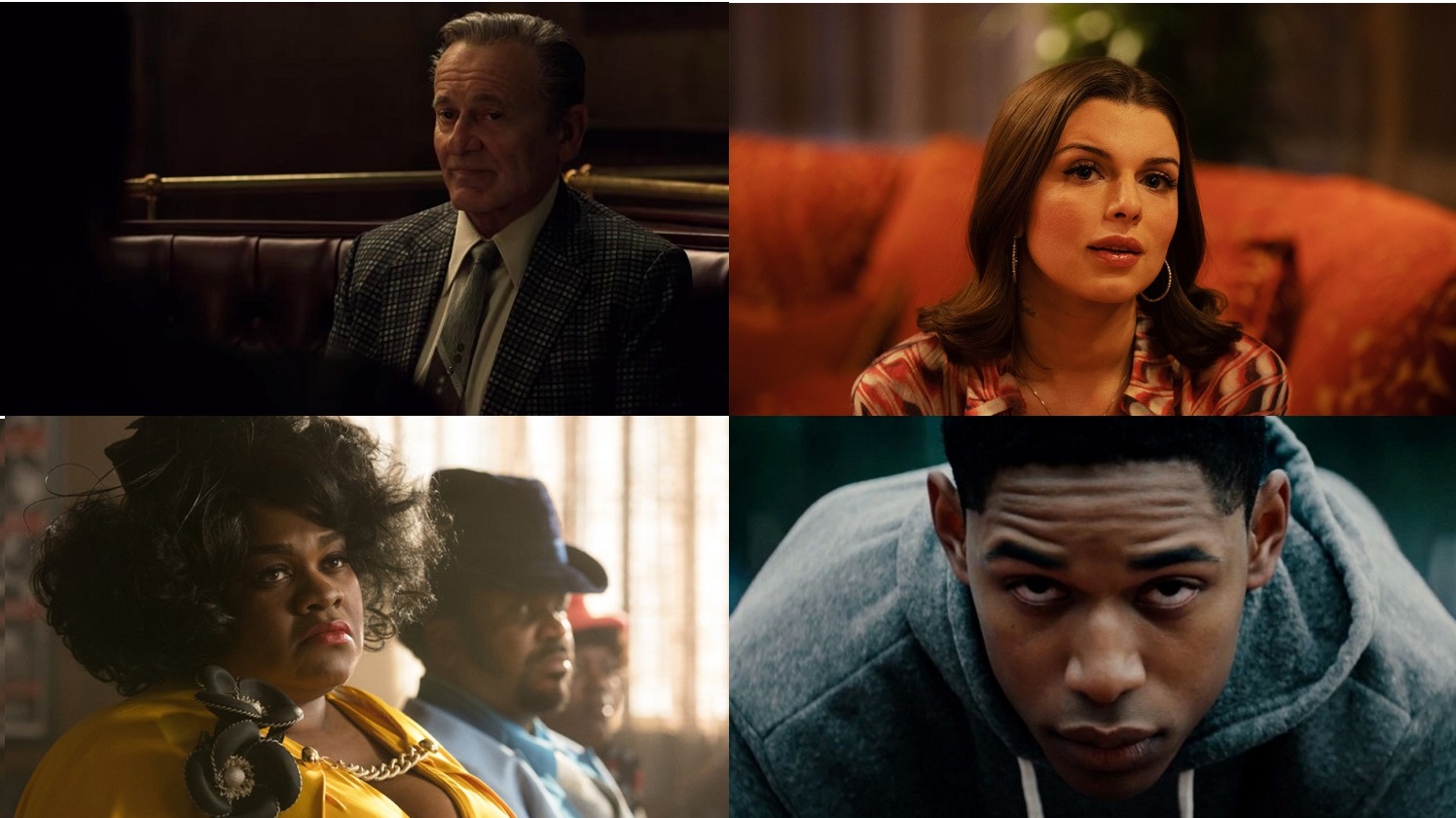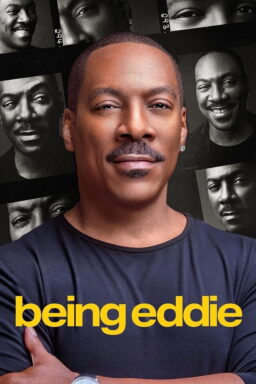What makes a great performance? People often conflate character with performance—thinking unforgettable characters must come from great acting. This is certainly partially true. There’s an art to crafting a character you’ll never forget. But why certain characters take up more real estate in our minds than others is still an issue that eludes a lot of people. One of the best ways to further the conversation about what makes a great performance is to highlight some of the best, picking out what works about them and why they’re so memorable. So we asked our staff to pick one performance from 2019 that they love enough to write about it. We did not demand that certain films or acting turns were included, so this is not a comprehensive feature, just a snapshot of great acting that shows not just the range of cinema this year but the varied tastes of the people who write about it for us.

Lupita Nyong’o as Adelaide/Red in “Us”
Films often ask performers to play multiple roles as something of a gimmick. It’s been done for comedic effect in something like “The Nutty Professor” or for philosophical examination in something like “The Double” or “Enemy.” No one has ever asked as much of a double performer as Jordan Peele asked of Lupita Nyong’o in “Us,” and the Oscar winner delivered one of the best performances of 2019 in return. As Adelaide’s worst fear comes to life and she witnesses the shadow version of her family sitting across the living room from her, the actress doesn’t just play good and evil – she goes much deeper than that. She sells both the depth behind the fear of who we presume is the “normal” Adelaide and the wounded monster who has been tied to her. For some reason, great acting has often become synonymous with either a great impersonation or a great couple of scenes. What’s most often ignored when we discuss acting is physicality. Watch what Nyong’o does with her body to both distinguish and tie the two versions of herself in “Us.” They are distinct and yet also mirrors of each other in so many ways. It’s the kind of performance one can break down scene by scene and appreciate with greater depth and nuance with each viewing. It’s not just a great 2019 performance, it’s an all-timer. (Brian Tallerico)

Jonathan Pryce as Cardinal Jorge Bergoglio in “The Two Popes”
When we first meet him, Cardinal Jorge Bergoglio is trying to make an airline reservation by phone; he has just become Pope Francis. His soft voice doesn’t portray frustration or anger when the person on the other end of the phone hangs up in disbelief. “The Two Popes” is based on script writer Anthony McCarten’s play and is a series of conversations. In the movie, music has meaning. At the 2005 enclave where Pope Benedict XI is chosen, Bergoglio is listening to ABBA, but there’s nothing in his step or posture that reveals a physical need to dance. His dancing is part of his Argentinian identity just like his devotion to soccer. What enfolds instead is a man who has given up much and believes the position of pope makes one a martyr. His demeanor is one of gentleness, of a grandfatherly embrace. One could imagine being at a milonga in Buenos Aires and being approached or approaching this kindly, gentle man and having a peaceful exchange, a flow of give and take. The subtext of the screenplay is not only the Old World of Europe versus the New World of the Americas (Bergoglio was the first Jesuit pope, the first from the Americas and the first from outside of Europe since Syrian Gregory III in the 8th Century), but also the American and European concept of what tango is. The secondary definition of tango in Merriam-Webster is “interaction marked by a lack of straightforwardness” and you’ll often hear soundtracks resort to tango to suggest a con, spies in action or other nefarious doings. That is not what is going on here. Pryce’s Bergoglio is open, honest and filled with compassion and an example of why the humble will inherit the earth. (Jana Monji)

Julia Fox as Julia in “Uncut Gems”
There seems to be nothing special about Julia Fox’s character during the first act of “Uncut Gems.” For a while, Julia, the girlfriend of Adam Sandler’s hustling protagonist Howard Ratner, appears to be just another bad decision on Howard’s part. Then, the two characters argue, and co-writers/directors Benny and Josh Safdie follow Julia in her walk of embarrassment, disappointment and sadness. In that moment, we realize there’s much more to this character than her tough, street-smart attitude. She genuinely loves Howard—more than he would allow himself to admit and probably more than he actually deserves. Julia begins along the lines of a sexy, entitled and naïve moll for Howard’s wheeler-and-dealer, but Fox’s performance, playing a woman who knows exactly who she is and what she wants, contradicts and then destroys that stereotypical characterization.
In a way, Julia becomes our last and, considering everything he does, only connection to the man Howard might have been, before his self-destructive nature overtook him. It’s not because a woman loves him. It’s because this woman—who doesn’t have anything to specifically gain from Howard and whom we know won’t put up with any B.S., unless she thinks it’s worth something—loves him. Once Howard’s final gamble to pay off his debt and satisfy the itch of his addiction begins, Julia becomes a key player in the character’s ultimate gambit, maneuvering a casino filled with potential threats to her, as well as to the possibility of Howard’s financial salvation. Fox commands as much attention as the climax of Sandler’s career-best performance, and her presence in that sequence is what provides it with so much tension. This is a star-making debut performance. (Mark Dujsik)

Jonathan Majors as Mont in “The Last Black Man in San Francisco”
Any good actor can play characters who have great speeches and witty dialogue, who express extreme and expressive emotions like passion, fury, shock, and who determine the direction of the storyline. But Jonathan Majors had to find a way to play Mont, a character who is quiet, gentle, and observant, literally along for the ride—he and his best friend Jimmie Fails ride one skateboard, holding on to each other. Majors showed us who Mont was with the subtlest expressions and gestures, all within the context of the film’s delicate, poetic lyricism.
Co-writer/director Joe Talbot told me that Majors improvised one of the movie’s most striking scenes, when Mont approaches a group of men standing on a sidewalk taunting those who walk by. They are a sharp contrast to Jimmie and Mont, who may not be realistic in their plans but who are always focused and active. Their constant commentary also functions like a Greek chorus. In the initial script, Mont was supposed to distract the group with a magic trick. But Majors suggested that Mont surprise the group by critiquing them as though they were in an advanced acting seminar with a shared vocabulary of dramaturgy. This reveals a lot about what Mont has been thinking and the way he sees the world. And it beautifully sets up a climactic moment near the end of the film. Mont finally speaks up, fittingly, first through a play and then directly, with a message he knew would be devastating for Jimmie. Majors shows us that Mont knows he risks ending the most important relationship he had, but knows it is essential for Jimmie’s well-being. Majors made Mont more than a sidekick, a fully-realized character of his own, ultimately someone we care about and root for—and perhaps wish we could be lucky enough to have as a friend ourselves. (Nell Minow)

Da’Vine Joy Randolph as Lady Reed in “Dolemite is My Name”
When Rudy Ray Moore meets Lady Reed for the first time in “Dolemite is My Name,” she is sitting at the club bar looking dejected. A scene earlier, Moore watched her in a violent altercation with her ex-boyfriend—he slapped her and she hit him back with the force of at least 2-1/2 Mike Tysons. Moore is more impressed by her presence than her punches. “Some people come with their own spotlight,” he tells her. It’s a fitting description for Da’Vine Joy Randolph, the actress who embodies Lady Reed with sincerity, humanity and a flair for profanity that matches her co-star, Eddie Murphy. Everything you need to know about Lady Reed is in this sequence showing her evolution into her singer/comedian alter ego, Queen Bee. Like Moore’s Dolemite, Queen Bee is as ribald and confident as her portrayer is humble and determined. Randolph expertly plays both sides of this in that introductory bar scene.
It starts with her calling bullshit on Moore’s offer to “buy the pretty girl a drink.” “I know what I look like,” she scoffs. “I ain’t pretty and I goddamn sure ain’t no girl. Then there’s this beautifully timed pause before she softly says, “I’ll have a daiquiri.” Her delivery is not just funny, it’s achingly vulnerable. These two have an immediate chemistry; she coaxes an unusual amount of charity out of Murphy’s performance and he encourages her confidence. As profane as their dialogue is, there’s an underlying sweetness that radiates so much love and support for one another. These two are kindred spirits, unconventional looking people who fearlessly put themselves on the big screen so that others may see themselves represented.
Randolph says as much in her poignant moment of thanks before the opening night of “Dolemite” in Chicago. At first, I thought this scene was extraneous, a verbal description of her performance. But then I realized that this dialogue needed to be heard. Because how often does one see big, beautiful, dark-skinned Black women onscreen? Director Craig Brewer gives Randolph the old-school glamour treatment and she gives “Dolemite is My Name” a beautiful dose of heart, soul and hilarity. To paraphrase Moore, she snaps into the performance and it’s magic. (Odie Henderson)

Paul Walter Hauser as Richard Jewell in “Richard Jewell”
There are some performances that take over movies, rocketing past the instincts of whatever director was hapless enough to ask some of our best talent to do better work than the movie deserves, and then there are performances that are given the perfect runway for an actor to take off. “Richard Jewell” is, blessedly, one such movie. Clint Eastwood films his star Paul Walter Hauser like he’s anybody ordinary, and it may even take you a scene or two to notice that this performance is as good as it is. Hauser plays a man so desperate to fit in that the movie doesn’t act as though it’s watching anyone special. Hauser’s Jewell is husky, nervous, thin-skinned, and loyal; the thing that’s so wonderful about the acting, from the way he stands, walks, even breathes (it’s a very subtly physical performance), is that Hauser is able to calculate Jewell’s unspoken desires. He wishes he had confidence, and believes that having his dream job in law enforcement will give it to him. Hauser’s performance is of a man trapped in a life, a house, a job, a body, a bad situation, who wishes with every part of his being that the trap reflected what he wants to believe he deserves, but can’t muster the ego. It’s some of the most assured and unassuming work by any actor this year, a guy who wanted to help people but lost his way and yet is possessed of the richest inner life thanks to the man playing him. Without Eastwood’s relaxed, generous direction picking up everything he does like Hauser were a dancer working for Vincente Minelli, we might not know just how incredibly talented he is. (Scout Tafoya)

Gabriela Cartol as Eve in “The Chambermaid”
Rigorous and repetitive is the work of Eve, who toils away day in and day out cleaning rooms at an opulent Mexico City hotel in Lila Avilés’ debut “The Chambermaid.” In this humanistic portrait of a determined young woman, actress Gabriela Cartol (“La Tirisia”) found a character without pretentions whose unspoken optimism to surpass her circumstances radiates truthfulness.
Cartol, a revelation of natural acting, constructs Eve’s life beyond the boundaries of her workplace via endearing and often downhearted phone calls with a son and his caretaker, both of whom we never see on screen. There’s also, on both a tangible and a metaphorical level, another source of motivation: a bright red dress kept away in the lost-and-found symbolizes a reward for all her dedication. Getting it is of crucial important for Eve.
She’s a model employee who aspires to move up and get an education, but above all Eve is observant. With a subtle smirk or a bright-eyed stare, Cartol imbues her with a mix of curiosity and guarded skepticism in her every interaction with guests and other employees. Eve won’t say much, but she registers it all.
It’s refreshing to watch Cartol personify a working-class mother who, despite of her socioeconomic circumstances, is not reduced to victimhood. Through Cartol’s measured rawness, Eve exhibits multiple layers of her intricate personality, from her sexual desires to outburst of anger, charming moments of levity, and even platonic affection with fellow chambermaid Minitoy (Teresa Sánchez), who encourages get rid of her serious expression.
But the most resonant aspect of what the how Cartol interprets Eve comes from her unwavering dignity. No matter how her time at the hotel concludes, she’ll thrive outside those doors because what defines her is not the job she holds, but her strength to remain unchanged through it all. Her red dress is still in the making. (Carlos Aguilar)

Franz Rogowski as Georg in “Transit”
Many have noted Franz Rogowski’s resemblance to Joaquin Phoenix—the wiry frame, the cleft lip, the general haunted nature. But where Phoenix, whether he’s going big or dialing it down, is a walking exposed nerve, Rogowski’s character in “Transit” is more reserved, a man who always seems to be holding back what he’s thinking or feeling to better protect himself. This allows other characters to project what they’re thinking or feeling onto him, and that’s key to “Transit”‘s success. Georg becomes a sort-of surrogate father to a young undocumented immigrant boy and a lover to Paula Beer’s Marie, the wife of an important political writer whose identification papers Georg has taken as his own. At first, we see only fleeting glances of what he’s actually feeling (as in this lovely scene of him fixing the boy’s radio and singing to him and his deaf-mute mother). It’s not immediately clear whether he’s purely opportunistic or whether he simply doesn’t have the heart to tell Marie that her husband committed suicide; all we know is that he’s quick on his feet and desperate to get out of Europe with her. It’s only gradually that Rogowski’s expressive eyes and body reveal a man whose survivalist instincts are overcome by guilt and need to do the right thing. Much like director Christian Petzold’s earlier “Phoenix,” “Transit” tells a story of looking for the right role to survive and the guilt that comes with survival, and Rogowski beautifully conveys what happens when self-preserving detachment falls away and a person’s humanity, the very thing worth preserving, takes over. (Max O’Connell)

Florence Pugh as Amy March in “Little Women”
In the 1950s, adult performers regularly played children. It was awkward and obvious, to say the least. So when it was announced that Florence Pugh, at 23, would play the teenage Amy March in Greta Gerwig’s “Little Women,” skepticism set in. But what Pugh does with the role of Amy is to quite literally transform in front of an audience’s eyes. Like the Amy March of Louisa May Alcott’s tome, Pugh is introduced as a vain teenager, worried about her nose and making moony-eyes at Laurie (Timothee Chalamet). She conveys the insecurity that comes from being youthful and fearful of being disliked, as well as the impetuousness and rash decision-making. When she burns Jo’s (Saoirse Ronan) manuscript only to delicately try to ice-skate with her, the transition between the two scenes shows a teenager desperate to make right the bond she’s ruined.
Even more impressive is when Pugh illustrates Amy’s transition from naive girl into dignified young woman. Where Amy March has often been a character despised for her selfishness and childishness, Pugh shows the stress of being deemed the one who will secure everyone’s safety. Because Amy is told she’s the only marriageable prospect in her family, Amy uses that knowledge to be smart about her heart. She genuinely loves Laurie but realizes he isn’t serious about his own life. Her confrontation scene opposite Chalamet, where Pugh lays out that a woman’s worth in marriage is to be property, her children included, emphasizes her stakes. She can marry for love, but only if that spouse understands her internal logic about marriage itself.
Florence Pugh’s Amy March shows a progression of time within a person, transitioning from a little girl into her own woman. She’s funny, relatable, and charming—the perfect Amy! (Kristen Lopez)

Kelvin Harrison Jr. as Luce in “Luce”
Beginning with Julius Onah’s “Luce,” a provocative film that follows a Black teenage track star and top student suffering through issues of identity and Black Excellence, Kelvin Harrison Jr. had a heavy year that would include “The Wolf Hour” and “Waves.” In “Luce,” Harrison Jr. plays the title character in a full-tilt yet controlled fit of incredible acting.
Nothing is ever what it seems in Onah’s film. “Luce” and the actor operate purely on a subconscious level, a side we’re rarely privy to except in brief flashes. In fact, part of the suspense arrives through us slowly realizing the character’s intent, and then doubling back when our initial read is proven wrong, and then doubling back again when we’re proven correct. When “Luce” premiered at Sundance, during the Q&A, Onah recounted his lone instruction to Harrison Jr. He ordered him to lose all of his Blackness. The young actor does so to startling results. Harrison Jr. purposely portrays this immigrant student from a war-torn African country as robotic, the idealization of the excellent Black student in the eyes of his white teachers and parents. But like “Get Out,” when the subconscious breaks into the conscious in a cry for help, Harrison Jr. portrays both cold suppression and hot bursts of anger with ease. The effect is a tête-à-tête between the performative and urgent reality of the character. A boy torn apart by expectations, by the pressures of lost identity.
By film’s end—we’re not sure if Luce knows who he is—he appears to accept the title of top student again, buying into its rewards while knowing the alternative punishment (failure) arrives in the form of an unforgiving outer world away from the safe suburban sprawl of his home. While Luce might not be unsure of himself, I’m completely conscious of Harrison Jr. He’s unforgettable. (Robert Daniels)

Adèle Haenel as Héloïse in “Portrait of a Lady on Fire”
For the first 20 minutes of Céline Sciamma’s fourth and finest film to date, we never see the face of its titular heroine, Héloïse (Adèle Haenel). When the reluctant bride-to-be charges up to the precipice of a cliff, if only to approximate the sensation of freedom, we are viewing her through the eyes of Marianne (a shattering Noémie Merlant), the artist assigned to paint her portrait. Haenel was romantically involved with the filmmaker for a period of time, and appeared in Sciamma’s first two directorial efforts, yet she—and Héloïse—are so much more than a muse. Just as Héloïse’s mother (Valeria Golino) notes that “it takes two to be funny,” an intimate meeting of the souls must occur between painter and subject in order for the latter’s inner life to be vividly etched on the canvas. The closer Marianne gets to Héloïse, the more Haenel allows us to glimpse the vulnerable, vibrant, fiercely passionate woman concealed within the embittered shell.
All of this leads to a glorious two-and-a-half minute close-up of Héloïse as she listens to an orchestra perform Vivaldi’s “Violin Concerto in G Minor,” a composition Marianne had once played for her, likening it to “a coming storm.” As the music mirrors the heightened memories of her affair with Marianne, Héloïse’s face transforms into a symphony of raw emotions. She closes her eyes and then dares to open them, breaking down in tears before smiling in exhilaration. Like a fleeting glance frozen in time, whether preserved via brush strokes or one’s subconscious, the suddenness and lasting impact of the storm echoed by Vivaldi is channeled through every nuance of Haenel’s astonishing performance. With fiery grace, she conveys how art can lend newfound clarity and closure to fragments from our past that would otherwise be too painful to bring into focus. (Matt Fagerholm)

Joe Pesci as Russell Bufalino in “The Irishman”
It is always interesting to watch performers show an unexpected side of their talent, and Joe Pesci in Martin Scorsese’s latest film “The Irishman” is one of such cases. As a calm, no-nonsense crime boss, Pesci looks much more understated than his volatile Oscar-winning supporting turn in “Goodfellas,” but there is also considerable intensity and authority lurking beneath his seemingly avuncular appearance, and we are always reminded of what his criminal hero is capable of. Sure, he prefers to handle troubles as sensibly and peacefully as possible, but, if there is not any other option as far as he can discern, this wise, thoughtful criminal does not hesitate to order whatever is necessary. At one point later in the movie, he talks quietly and discreetly as usual, but his final decision on his latest problem feels intractable and adamantine to us nonetheless, and his firm demand is expressed with the bitter sense of inevitability and resignation as Pesci phlegmatically delivers that recurring line in the film: “It’s what it is.”
After “Lethal Weapon 4,” Pesci was in semi-retirement status during the next two decades, while appearing in only a couple of feature films. But he surprises us here, demonstrating that he has not lost none of his talent and presence. I do not know whether he will go further after “The Irishman,” but, considering that he still can be at the top of his game as before, I hope there will be several more movies to interest him in the future. (Seongyong Cho)

Elisabeth Moss as Becky Something in “Her Smell”
Were we to look at the year’s performances on a purely technical level, few would measure up against the work Elisabeth Moss does in Alex Ross Perry’s frenetic, quietly terrifying “Her Smell.” Take one of the film’s best punchlines, arriving near the point in the film’s second act in which dread crests like a wave. Moss’ Becky Something, a spiraling punk rock icon/addict in free fall, sizes up the three young members of new band The Aker Girls; she smells them, caresses them, bites them. Then finally, having somehow convinced them to become her backing band, she opens the door to the recording studio and says, with confusion, impatience, and humor, “Inward, ho!” It’s a perfect joke, delivered perfectly by Moss, but it’s also an indication of the mental capacity of this absolute trainwreck, a brief glimpse of the brilliant mind that led her to such heights—she’s not proud of the joke; it’s just another piece of cleverness. And on top of all that, it’s also an act, and Moss lets us see the greasepaint. Becky’s playing Becky the idol, making a discovery instead of grabbing desperately for one last rung on the ladder.
There are many such moments in “Her Smell”; Moss also learned to play guitar for the film, the kind of thing that typically has award-granting bodies salivating. But what really makes it among the best performances of not just the year but the decade is the stuff that feels a lot less technical. The moments when Becky stops tearing through life and stares herself down in the mirror. When she stands at the end of a hallway, frozen by fear, and just the slightest sway of her arms makes it appear something could be very wrong. The hair tossing, the stumbles, the lightning-fast switches in focus that seem too instinctive to be planned. These two incredible qualities can be glimpsed in one brief moment of the unforgettable “Heaven” sequence, when Becky stops singing the most beautiful, heartbreaking rendition of a Bryan Adams song ever committed to film to turn and nod gently to the daughter she barely knows. A beautiful song and a simple, human, undeniably human moment. Craft and all that can’t be taught, glimpsed in one. (Allison Shoemaker)

Adam Driver as Charlie in “Marriage Story”
Charlie, the Brooklyn theater director whom Adam Driver plays in writer/director Noah Baumbach’s delicate and devastating “Marriage Story,” seems indefatigable to his soon-to-be ex Nicole (Scarlett Johansson). That’s one of the things she loves about him, writing a letter at a mediator’s request, a kind start to the end of their relationship as a couple: “He rarely gets defeated. I feel like I always do.” But as dogged as Charlie is in negotiating their separation and divorce, he’s also making up the route as he goes along.
Both Driver and Johansson turn Charlie and Nicole into fully realized, three-dimensional characters that Baumbach treats with empathy, but Driver stayed with me longer afterward. “Marriage Story” feels more like his journey because Driver portrays Charlie not as a narcissist but as a guy who genuinely didn’t realize how much he took for granted. Nicole’s unhappiness truly blindsides him, and he cycles through every bit of denial, anger, depression, and eventual forgiveness—not just for Nicole but for himself as well. Charlie would be easy to dislike, the partner who’s unfaithful in this painful pas de deux, who uses the f-word at his eight-year-old son, insists on trick-or-treating way past bedtime so he gets in time with the boy, but he’s also barely holding it together, trying too hard, and humiliating himself. He says, “We’re a New York family” like a mantra, until they’re not; wants his son to know he fought for him; punches drywall, crumples in tears, bleeds, even sings. I cried too watching this movie, mostly because of Driver, who becomes tremulous when he hears the words Nicole meant for him, feels defeated after all, and learns to start anew. (Valerie Kalfrin)

Jessie Buckley as Rose-Lynn in “Wild Rose”
In “Wild Rose,” Jessie Buckley’s natural sense of timing overrides situational acting tendencies, and pinpoints what drives the best music-themed dramas: authentic moments that imply the lead fully understands all the performative nuances of not only just the subject, but also the subject’s craft.
“Wild Rose” begins with a message moment, as Buckley’s Rose-Lynn Harlan leaves jail with so-called “swagger.” To reinforce a message of personal empowerment, the title character shakes her fist with all the might of a late ‘70s punk rock star. However, Buckley seems to favor her character’s confidence over appearance. It’s all about the timing of Rose-Lynn’s movements; how the lead actress lives in the moment rather than reacting stiffly to script dialogue.
For example, Rose-Lynn seeks financial support from a woman who has good intentions, but also clearly doesn’t understand the grind. Buckley, fully in tune with the “wild” aspect of her character’s persona, excels during a “Three Chords and the Truth” tattoo reveal; a harmonic moment that at once conveys Rose-Lynn’s awkwardness and a sense of conversational intelligence that speaks to her ability to connect.
“Wild Rose” doesn’t require a proper stand-out performance from Buckley to succeed, as the protagonist’s persona caters to a specific group of people, while the music itself appeals to various demographics. Yet Buckley doesn’t simply deliver a PG-13 passable performance. Instead, she pinpoints all the nervous energy of a truly flawed social outcast who thrives on confidence in unique social situations. She’s natural and believable; she’s someone’s neighbor from every block around the world. (Quinn Hough)

Mark Ruffalo as Robert Bilott in “Dark Waters”
In Todd Haynes’ “Dark Waters,” Robert Bilott (Mark Ruffalo) shrinks. Aloof and confident, Bilott is the type of man to drive hours across State lines for his grandmother. He’s not imposing and might fade into the background of any crowd, but he is proud of his accomplishments. Throughout the film, as he pursues a decade-long legal fight against the Dupont chemical company, though, this pride fades. For a lawyer, Bilott doesn’t talk a lot. He spends more time listening, and the emotional weight of those testimonies crush him smaller and smaller. A man who once knew where he was going, turns inward; his body becomes stiff, almost contorted. He develops a tremor in his hand. Rage festers below his quiet exterior and paranoia encroaches into his home. His pursed lips that once seemed relax, tense-up. But even as he pulls up carpets, sorts through pots and pans in the middle of the night, it’s done quietly.
“Dark Waters” isn’t a celebratory tale of heroism. This film doesn’t celebrate individualism, even if Bilott is an exceptional person. It is what happens when corporations are allowed to act according to their nature, putting profit margins above everything else. Bilott has to be small in comparison to the monster that keeps growing and growing. Ruffalo’s performance not only works as a portrait of a man on the verge of disappearance but works within the scope of a film bigger than any individual fight. The corporations like Dupont have not only changed our body chemistry but the way we think. There’s little outrage, even tired resignation is too much to ask. Bilott keeps fighting even if it’s clear that Dupont has already won. (Justine Smith)











